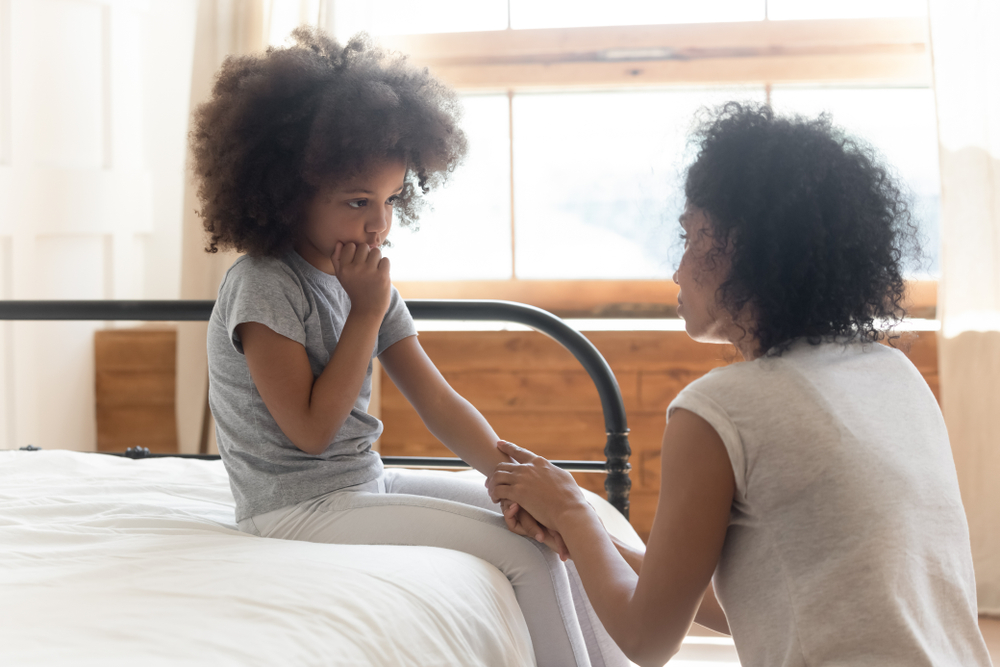Preschool-2nd Grade
Young children can worry just as much as adults.
What do preschoolers worry about?
They don’t really have the ability to worry about big, abstract concepts, so they tend to concretize their worries into things like:
- The dark
- Loud noises
- Animals
- Monsters
What about K-2?
Generalized worries tend to cluster around losing the things that make them feel safe.
- Something will happen to me–I’ll get hurt or sick
- Something will happen to my parents—they will get hurt or sick
- Being kidnapped (sounds weird to grownups, but often reported as fear by children)
- Family moving away and not telling them
Symptoms of anxiety in young children
Because young children are not as articulate as adults or older children, their anxiety may manifest in physical symptoms like:
- Tummy aches
- Sleep disruption
- Irritability
- Being clingy
- Loss of appetite
- Anger/aggression
What about Covid-19?
Because young children’s worries tend to center around what keeps them feeling safe, anxiety about Covid-19 can be significant. Many families have reported increased worry in their children, even if no one in their family or social circle is sick.
What can you do to help?
Step 1: Validate before problem solving.
Even if there is nothing specific that has happened to cause their worries, they feel very real to children. Tell them you understand. You can simply state, “You are really worried about that.”
Step 2: Assurance.
Assure your child that they are safe and healthy and you are safe and healthy–and you will take care of them.
Step 3: Problem solve.
Put concrete hygiene procedures in place at home: washing hands before eating, after using the bathroom, returning home after errands. Keep explanations simple: “Washing hands helps us stay healthy.”
Check in frequently about how they are feeling. You don’t have to fix it. Checking in, by itself-is often all that is needed.
Mental rehearsals: especially about putting on masks, seeing others in masks, etc.
Before an event that might worry your child, talk them through the different steps that will happen, what they might see, etc. Use positive, encouraging language. “It might look weird, since you can’t see people’s smiles, but I know you can handle it.”
Tell stories: Young children respond really well to story characters who are going through similar situations. You can make up a story about ‘another little boy or girl’ who was worried, or scared, etc. and how they overcame their fears.
For K-3: Story time, puppet show and art project from Look, Listen and Learn
Season 1, Episode 8 Why Worry?
https://youtu.be/n3LHk1ObmAY
Create a feel-good box or backpack.
Fill it up with things that help your child self soothe when upset. For example:
- A stuffed animal they love
- A picture of their friends
- Special crayons and fancy notebook for coloring
- A soft blanket for cuddling
Take care of yourself
Verbalize what you do for self-care, and role model. For example, if you’ve had a stressful day, you can say out loud, “Phew, I’m feeling really stressed right now. I need to stretch, and then listen to my favorite song to feel better!”
Teach relaxation strategies. Here are some examples:
- Breathing (note—teach how to slow breathe, not deep breathe. Young children often gasp in air when trying to deep breath. This is not relaxing! Use slow breathing instead—blowing soap bubbles is a great way to teach this, or blowing on a pinwheel.)
- Physical activity (dance party, run up and down the stairs, run around the house 3 times)
- Weighted blanket for cuddling
- Cuddling with parent or pet
- Read a favorite story
- Look at family photos. Create a photo album, not on the computer. Look through it with your child and tell stories.
- Laughter. Watch a funny video clip. Listen to a funny family podcast.
Create a daily routine–and document it for them to follow.
Everyone’s daily schedule has been upended by Covid-19. Children need consistency to feel safe. When they can predict what will happen next, they feel more control. This will help ease worries.
- Create a daily schedule and post it where your child can see.
- Review it in the morning together.
- If different family members have different schedules, create charts for each one.
- Use pictures to help your young child understand the different components of the day. You can cut out pictures from magazines or
- print out from internet.
For example:
-
- Breakfast (picture of cereal bowl)
- Get dressed (picture of clothing)
- Free play inside (games, toys, etc.)
- Snack (picture of apple slices)
- Neighborhood walk time or play outside (picture of trees, family walking together)
- Tidying Up (picture of vacuum, broom, laundry basket)
- Lunch (picture of sandwiches)
- Nap/rest time with stories (picture of child resting in bed or on couch)
- Free Play (games, crafts)
- Outside time (picture of your yard, or outside play toys)
- Dinner (picture of family meal)
- Clean up (doing dishes, putting toys away)
- Family activity (e.g. stories, listen to family podcast)
- Get ready for bed, brush teeth (toothbrush, washcloth)
- Bedtime (child in bed)
Reach out for support: Call the Family Help Line
You can always call Parent Trust’s Family Help Line for more ideas, or help thinking through a situation with your family. Our parent coaches can offer support, help problem solving, and connect you to local resources. 1-800-932-4673 or email familyhelpline@parenttrust.org

